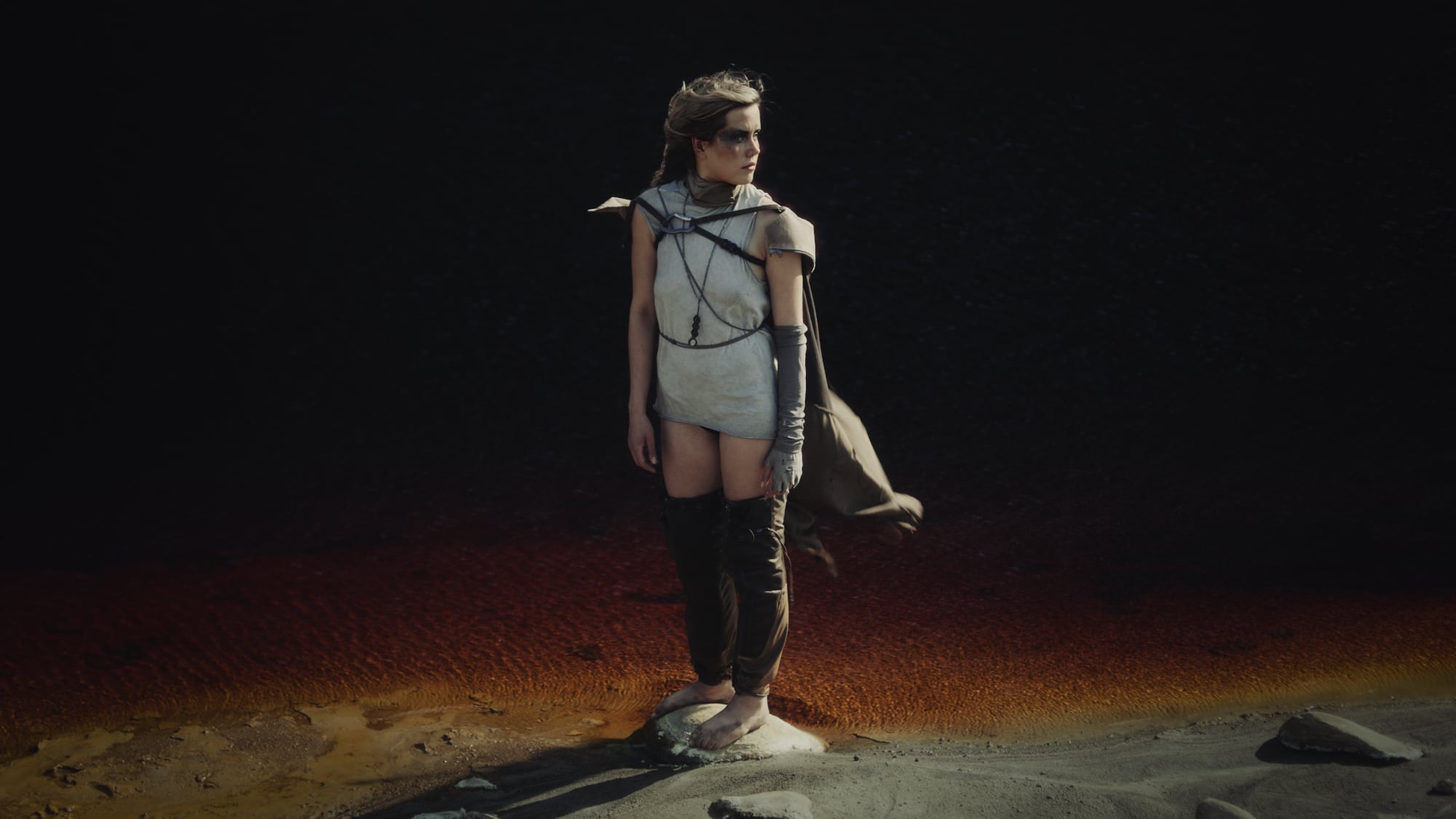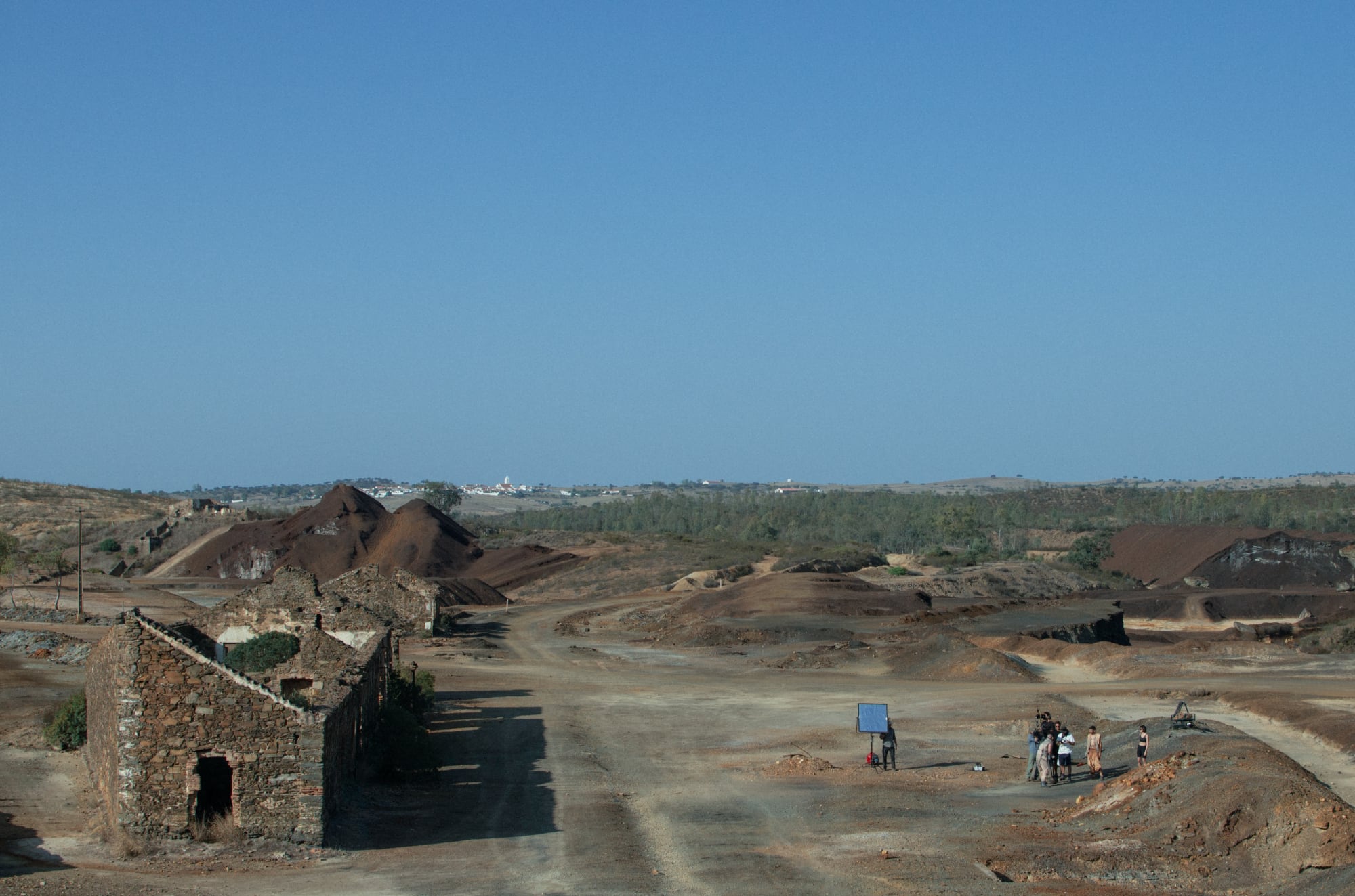
The challenge of crafting great science fiction lies in the balance of a compelling narrative and thorough worldbuilding. When you’re embracing the task of creating a new world every facet of it needs to be thought through, otherwise your idea can crumble at the first hurdle. This all-encompassing approach is key to Tomas Kamphuis’ ambitious and detailed sci-fi fashion short EXILES. Made in collaboration with Hamcus and Adidas, Kamphuis’ film relishes every element of its story. From the inventive costuming through to the gorgeous, dusty visuals you can tell each part of this film has been deliberated over with great intent. Now, with the film recently arriving online, DN speaks with Kamphuis for an extensive conversation about the making of his short, the location-based challenges that arose during the shoot, and the visual language he employed to emphasise the film’s narrative and its fashion.
EXILES is a unique project in that it bridges sci-fi drama with the fashion film, how do you contextualise it to those who ask about it?
EXILES is a short sci-fi/fashion film made in collaboration with Hamcus and Adidas. It follows individuals struggling to survive amidst a harsh drought. The film delves into the lives of the Roamers, a group with a supernatural connection to the planet, a nomadic transmitter searching for hope through radio signals, mine workers trapped in a cycle of struggle, and students dreaming of a better future. A celestial event suddenly brings hope and unity to this barren world, intertwining the lives of these solitary beings. It’s a tale of resilience, serendipitous encounters, and the rebirth of hope in a forgotten landscape, all while seamlessly integrating fashion into the narrative.
When did inspiration for this short, and the blend of sci-fi and fashion, begin for you?
My interest in this blend began when I reached out to Tuff, the founder of Hamcus, back in late 2022. I’ve always had a keen interest in sci-fi, and I was really impressed by Hamcus’ style. It seemed like the perfect opportunity to merge these two worlds. Tuff was very excited about the idea, and as we discussed more, I discovered that Hamcus was much more than a fashion brand. Tuff had created an entire universe with its own planets, cities, and ecosystems. He generously shared all his conceptual work with me, giving me total freedom to develop a film set in this universe. The planet that particularly stood out was Lower Planetary, which was also the focus of Hamcus’ current collection. It’s a planet with vast dry landscapes and barren lands, contrasting with a wealthy city that harnesses energy from a star. Everyone outside the city lives in difficult conditions. This backdrop inspired me to tell a story about a celestial event that brings a change, offering hope and balance to this struggling part of the planet.


As with any science fiction film, location is key, what were you looking for? And where did you find it?
The scouting and casting process for EXILES was quite an adventure. For locations, I was seeking landscapes that would authentically represent the stark and barren terrain of Lower Planetary. This search led me across various parts of Portugal and Spain. I was particularly drawn to places that naturally had an alien, otherworldly feel to them, like abandoned copper mines and vast stretches of dry, arid land. These locations were crucial in bringing the planet Lower Planetary to life on screen, providing a tangible sense of the harshness and struggle of life outside the city.
Did you have a somewhat similar approach to casting?
Casting was an equally unique experience. Given our budget constraints and the project’s experimental nature, I decided to involve friends and people I had met in local bars. This unconventional approach brought a diverse and authentic energy to the film. The cast was a mix of seasoned actors and complete novices, which I found added an interesting dynamic to the production. Each person brought their own unique interpretation to the characters, enhancing the raw and genuine feel of the film. This blend of meticulous location scouting and unconventional casting was key in setting the tone. It allowed us to create a world that felt both alien and relatable.
Can you tell us about your collaboration with Kevin Kimman, the cinematographer, and how you decided on the film’s visual approach?
From the outset, we agreed that the film needed a distinct visual language that could do justice to both the sci-fi elements and the fashion aspects of the narrative. My background in editing usually leans towards crazy transitions with the help of intense camera movements but for this film, we decided to challenge ourselves with a different approach. We focused on more static shots, putting a stronger emphasis on the emotion within each scene, the depth of the locations, and the detailed styling of the characters. The idea was to capture each frame with a certain elegance, almost as if every shot could stand alone as a piece of art.
We focused on more static shots, putting a stronger emphasis on the emotion within each scene, the depth of the locations, and the detailed styling of the characters.
Kevin’s expertise was invaluable, especially in how we utilized natural light to convey the mood and atmosphere of Lower Planetary. We used minimal artificial lighting, relying on reflectors and flags for subtle enhancements. This approach not only helped us stay true to the authentic feel of the scenes but also added a layer of realism and depth to the visuals.



How did you integrate fashion into the film’s narrative, and what was the process of collaborating with Hamcus on that part of production?
The integration of fashion was an important aspect of the film, and working with Hamcus, especially Tuff, was key to this. Our goal was to ensure that the fashion elements were not just visually striking but also deeply intertwined with the narrative and characters. Nico Gaudenzi, our stylist and art director, played a significant role in this process. We had extensive discussions about which pieces would best fit each character, considering the harsh environment of Lower Planetary and how this would influence the clothing. It was essential that the fashion reflected the personalities and lifestyles of the characters, adding depth to the storytelling.
One of the most exciting parts of our collaboration was designing custom pieces for the Roamers, a group of characters in the film. These pieces were created to reflect their unique place in the story, blending the ruggedness of their lifestyle with the distinctive style of Hamcus. We worked closely with Tuff to define these custom outfits, ensuring they were not only functional but also aesthetically aligned with the world of Zone 3. Nico’s expertise was invaluable in bringing these designs to life. Once the clothing arrived from China, Nico meticulously styled each outfit, ensuring every detail was perfect for the scenes. This close collaboration between our team and Hamcus allowed fashion to become an integral part of the film’s narrative.






Could you share some insight into the shooting process, particularly how you managed to work within the constraints of the aforementioned limited budget?
Certainly. One of the biggest challenges during the production was dealing with the harsh environmental conditions. We shot during one of the hottest periods of the year, with temperatures soaring to 45 degrees Celsius in some of the most heat-intensive areas of Europe. This extreme weather posed a significant challenge, not just in terms of the comfort and safety of our cast and crew, but also in maintaining the integrity of our equipment and shooting schedule. It required a lot of resilience and adaptability from everyone involved.
Our goal was to ensure that the fashion elements were not just visually striking but also deeply intertwined with the narrative and characters.
On a personal level, I had moments of doubt and concern. I had brought together almost 20 people, all contributing pro bono, and asking them to work in such demanding conditions. There was a constant worry in the back of my mind about whether I had taken on too much, whether the project was too ambitious for our budget. In the end, the tough conditions actually brought the crew closer together. We started the project as a group of relative strangers and ended up forming a tight-knit bond, much like a family.

What was your experience with post-production on EXILES? Were there any creative decisions made at that stage which were pivotal in shaping the final version of the film?
During post-production, we made some key creative choices that significantly shaped the film. One of our main objectives was to convey the transformation of Lower Planetary from a barren state to one of rejuvenation. To illustrate this visually, we experimented with chemical reactions and live microscopic footage. These elements became symbolic bookends to the film, with the opening titles featuring the chemical reactions to depict the planet’s deterioration, and the closing scenes showcasing living organisms to represent nature’s revival. This metaphorical portrayal was crucial in highlighting the central theme of ecological renewal. Kevin also crafted a unique visual effect for the scenes featuring the Roamers. He shot sand textures on a glass plate with lighting from beneath, creating a mesmerising ‘glowing earth’ effect, adding a mystical and otherworldly quality to their part of the story. It visually distinguished their connection to the planet, aligning with their narrative significance.
In the end, the tough conditions actually brought the crew closer together.
The soundtrack, crafted by Maurits, known as Nachtbraker, was another vital component. His transition from electronic music to a more orchestral, cinematic style brought an unexpected depth to the film. His ability to create a score that resonated with the film’s themes and moods was remarkable, adding layers to the storytelling experience, especially considering the absence of any voice-over or dialogue. We also invested significant effort into the sky replacements and set extensions. These visual effects were key in creating a believable and immersive world for Lower Planetary. The sky replacements, in particular, were challenging but essential. We needed to ensure that the skies in our scenes matched the unique atmosphere and tone of the film, contributing to the sense of being on a different planet. These enhancements helped us overcome the limitations of our filming locations, transforming them into the alien landscapes of Lower Planetary.

What’s coming up for you, in regards to your filmmaking?
Moving forward, I’m excited to continue operating within the realm of fashion, futuristic aesthetics, and cutting-edge technologies. I’ve been experimenting extensively with AI and Unreal Engine, exploring the possibilities they offer for immersive storytelling and visual effects. Additionally, I’m particularly intrigued by the potential of Augmented Reality and its implications for creative expression.
On a separate note, I have a documentary project titled Art Chooses Us in the pipeline, focusing on four African artists. This project delves into the intersection of art, culture, and identity, offering a unique perspective on the diverse artistic landscape of Africa.


